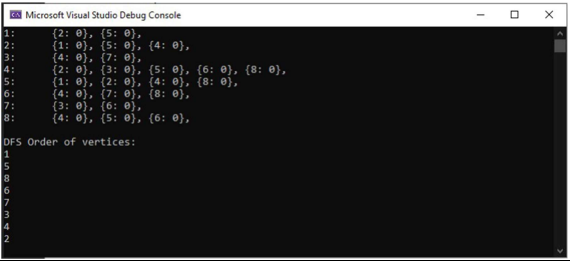Please help me debug this code, expected output is attached below.
Implementing Depth First Search
#include <string>
#include <
#include <iostream>
#include <set>
#include <map>
#include <stack>
template <typename T>
class Graph;
template <typename T>
struct Edge
{
size_t src;
size_t dest;
T weight;
// To compare edges, only compare their weights,
// and not the source/destination vertices
inline bool operator<(const Edge<T> &e) const
{
return this->weight < e.weight;
}
inline bool operator>(const Edge<T> &e) const
{
return this->weight > e.weight;
}
};
template <typename T>
std::ostream &operator<<(std::ostream &os, const Graph<T> &G)
{
for (auto i = 1; i < G.vertices(); i++)
{
os << i << ":\t";
auto edges = G.outgoing_edges(i);
for (auto &e : edges)
os << "{" << e.dest << ": " << e.weight << "}, ";
os << std::endl;
}
return os;
}
template <typename T>
class Graph
{
public:
// Initialize the graph with N vertices
Graph(size_t N) : V(N)
{
}
// Return number of vertices in the graph
auto vertices() const
{
return V;
}
// Return all edges in the graph
auto &edges() const
{
return edge_list;
}
void add_edge(Edge<T> &&e)
{
// Check if the source and destination vertices are within range
if (e.src >= 1 && e.src <= V &&
e.dest >= 1 && e.dest <= V)
edge_list.emplace_back(e);
else
std::cerr << "Vertex out of bounds" << std::endl;
}
// Returns all outgoing edges from vertex v
auto outgoing_edges(size_t v) const
{
std::vector<Edge<T>> edges_from_v;
for (auto &e : edge_list)
{
if (e.src == v)
edges_from_v.emplace_back(e);
}
return edges_from_v;
}
// Overloads the << operator so a graph be written directly to a stream
// Can be used as std::cout << obj << std::endl;
template <typename T>
friend std::ostream &operator<<<>(std::ostream &os, const Graph<T> &G);
private:
size_t V; // Stores number of vertices in graph
std::vector<Edge<T>> edge_list;
};
template <typename T>
auto depth_first_search(const Graph<T> &G, size_t dest)
{
std::stack<size_t> stack;
std::vector<size_t> visit_order;
std::set<size_t> visited;
stack.push(1); // Assume that DFS always starts from vertex ID 1
while (!stack.empty())
{
auto current_vertex = stack.top();
stack.pop();
// If the current vertex hasn't been visited in the past
if (visited.find(current_vertex) == visited.end())
{
visited.insert(current_vertex);
visit_order.push_back(current_vertex);
for (auto e : G.outgoing_edges(current_vertex))
{
// If the vertex hasn't been visited, insert it in the
stack.if (visited.find(e.dest) == visited.end())
{
stack.push(e.dest);
}
}
}
}
return visit_order;
}
template <typename T>
auto create_reference_graph()
{
Graph<T> G(9);
std::map<unsigned, std::vector<std::pair<size_t, T>>> edges;
edges[1] = {{2, 0}, {5, 0}};
edges[2] = {{1, 0}, {5, 0}, {4, 0}};
edges[3] = {{4, 0}, {7, 0}};
edges[4] = {{2, 0}, {3, 0}, {5, 0}, {6, 0}, {8, 0}};
edges[5] = {{1, 0}, {2, 0}, {4, 0}, {8, 0}};
edges[6] = {{4, 0}, {7, 0}, {8, 0}};
edges[7] = {{3, 0}, {6, 0}};
edges[8] = {{4, 0}, {5, 0}, {6, 0}};
for (auto &i : edges)
for (auto &j : i.second)
G.add_edge(Edge<T>{i.first, j.first, j.second});
return G;
}
template <typename T>
void test_DFS()
{
// Create an instance of and print the graph
auto G = create_reference_graph<unsigned>();
std::cout << G << std::endl;
// Run DFS starting from vertex ID 1 and print the order
// in which vertices are visited.
std::cout << "DFS Order of vertices: " << std::endl;
auto dfs_visit_order = depth_first_search(G, 1);
for (auto v : dfs_visit_order)
std::cout << v << std::endl;
}
int main()
{
using T = unsigned;
test_DFS<T>();
return 0;
}

Step by step
Solved in 2 steps with 2 images









